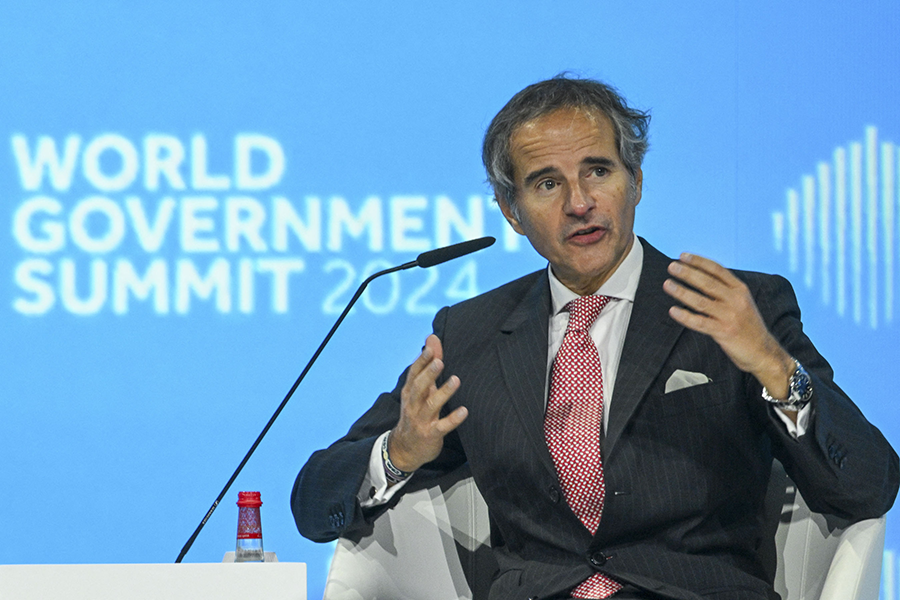IAEA Warns Iran About Lack of Transparency
March 2024
By Kelsey Davenport
Iran’s failure to provide full transparency into its nuclear program is increasing risk, the head of the International Atomic Energy Agency (IAEA) warned.
 IAEA Director-General Rafael Mariano Grossi said on Feb. 13 that Iran is “not entirely transparent” regarding its nuclear activities, which “increases dangers,” particularly given the “accumulation of complexities” in the Middle East.
IAEA Director-General Rafael Mariano Grossi said on Feb. 13 that Iran is “not entirely transparent” regarding its nuclear activities, which “increases dangers,” particularly given the “accumulation of complexities” in the Middle East.
In addition to seeking answers about undeclared uranium activities at two sites from the pre-2003 period, when Iran had a nuclear weapons program, Iran is not providing the IAEA with design information about new nuclear facilities, as required by its safeguards agreement, or following through on a voluntary commitment in March 2023 to enhance agency monitoring at sites that support the country’s nuclear program but do not hold fissile materials.
Grossi, speaking at the World Governor’s Summit in Dubai, also referenced an uptick in “loose talk about nuclear weapons” in Iran and said a “very high official said…we have everything” to make a nuclear weapon.
Grossi’s remarks appeared to refer to a comment by Ali Akhbar Salehi, former foreign minister and head of the Atomic Energy Organization of Iran (AEOI) from 2013 to 2020. Asked if Iran has the capability to produce nuclear weapons in a Feb. 11 interview with Nasim TV, Salehi said that the country has crossed “all the scientific and technological nuclear thresholds” necessary to build a weapon.
Salehi’s declaration that Iran has a nuclear weapons capability is not surprising. The U.S. intelligence community has long assessed that Iran has the technical and scientific capacity to build a nuclear weapon if the political decision is made to do so.
Iranian officials, including the current head of the AEOI, Mohammad Eslami, continue to say Iran is not interested in nuclear weapons. In a Jan. 13 interview with Ofogh TV, Eslami said that nuclear weapons are not part of Iran’s defense and security strategy. He said Iran can build a nuclear arsenal but “we do not want to do it.”
Regardless, clashes between the United States and Iranian-backed forces in the region increase the risk that Tehran could determine that the benefits of pursuing nuclear weapons outweigh the costs.
Iran’s nuclear advances since U.S. President Donald Trump withdrew the United States from the 2015 nuclear deal, known as the Joint Comprehensive Plan of Action, in May 2018 would allow Tehran to produce enough weapons-grade fissile material for five bombs in about four weeks. U.S. officials have suggested that the weaponization process could take another six to 12 months.
The speed at which Iran could produce enough fissile material for a nuclear weapon is due largely to Iran’s growing stockpile of uranium enriched to 60 percent uranium-235, a level just shy of the 90 percent-enriched U-235 that is considered weapons grade.
The IAEA reported in December that Iran accelerated the production of 60 percent-enriched U-235 after a decrease in production from June through November. But in a Feb. 19 interview with Reuters, Grossi said Iran had again decreased the rate of production.
He said Iran’s recent changes to the rate of production of 60 percent-enriched U-235 “does not alter the fundamental trend,” which is a “constant increase in inventory” of highly enriched uranium.”
Iran does not have any practical need for uranium enriched to 60 percent U-235. The country’s sole operating nuclear power reactor, at Bushehr, runs on uranium enriched to less than 5 percent U-235, and Russia provides that fuel. Iran operates a research reactor with fuel that uses uranium enriched to 20 percent U-235, which Tehran imports.
Iran recently announced the start of construction on several new reactors but none of the units will require fuel with 60 percent-enriched U-235.
On Feb. 5, Eslami said Iran began pouring the foundation for a new research reactor at Esfahan that will be used to produce isotopes for medical treatments and industrial purposes.
The previous week, Iran began constructing a new nuclear power plant. The site, located on Iran’s east coast, will include four reactor units and take nine years to build, according to Eslami.
Iran did not notify the IAEA when it began construction of these facilities, as required under its safeguards agreement. Iran maintains that it suspended the safeguards provision, known as modified Code 3.1, that requires it to notify the agency when the decision is made to construct a new nuclear facility. Iran says it will abide by the previous requirements, which stipulate that a country must notify the IAEA 180 days before nuclear material is introduced into a facility.
The IAEA argues that Iran cannot unilaterally suspend modified Code 3.1. The agency changed the notification requirements to give inspectors a longer lead time to develop effective safeguards.
While in Davos for the World Economic Forum in January, Grossi emphasized the importance of Iran providing more transparency regarding its nuclear program. He also said it is “unacceptable” for Iran to “hold the IAEA hostage” over “political disputes with others.” Specifically, Grossi said Iran is punishing the agency because of actions taken by France, the United Kingdom, and the United States that Iran’s leaders consider to be objectionable.
He called for diplomacy to prevent the “situation deteriorating to a degree where it would be impossible to retrieve.”
